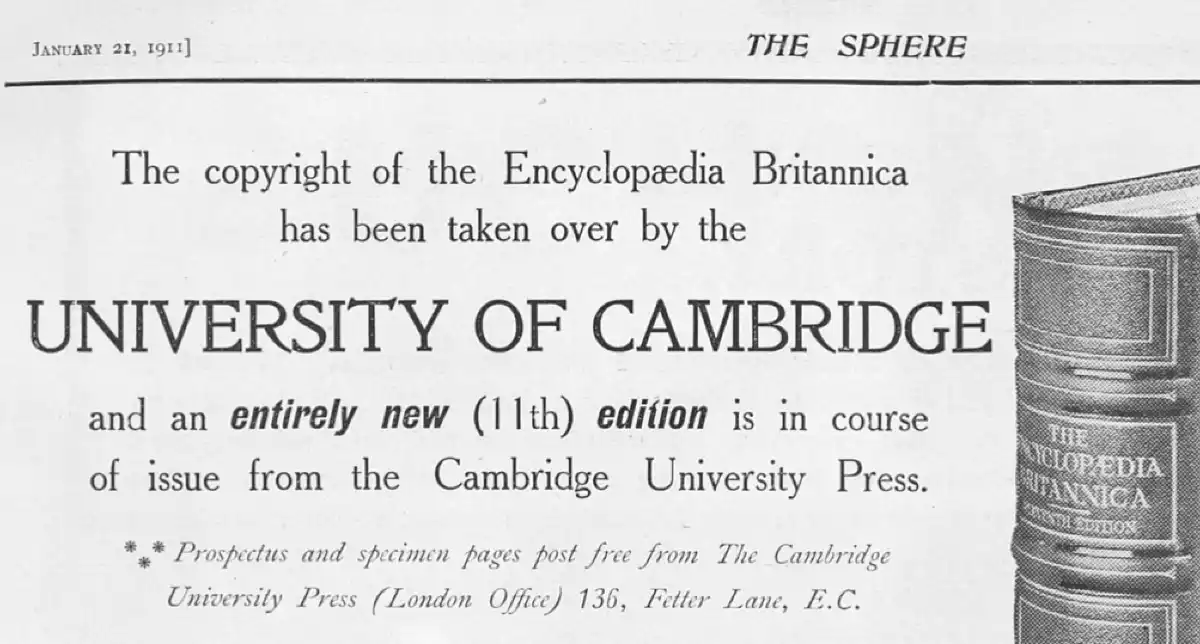In the garbage.
That’s where I found them. Outside and below the Humanities building, here at the
University of Victoria. A complete set of the famous 11th edition of Encyclopædia Britannica, 1910-1911 (EB11), including the so-called three New
Volumes,
which, along with EB11,
constitute the 12th edition of 1922. Count ʼem: thirty-two volumes. In decent shape,
too.
Cool. And somehow appropriate, but that’s another story.
I of course salvaged them, somewhat discreetly. Not quite dumpster diving, but close
enough to momentarily reincarnate metaphorical phrasing made famous by Leon Trotsky in
dismissing his political opponents, but now suddenly literal: the dustbin of
history
(there’s various translations: garbage heap, trash heap, dust heap—but
you get the point). As a revolutionary communist (of the Bolshevik variety), Trotsky
makes the remark in 1917.
At the same time, across the English-speaking world, the vast, relentless marketing
machine behind EB11 continues to stridently
advertise its own revolution (of the capitalist variety) by pushing the necessity of its
massive version of canonical knowledge for any (as it says) intelligent
Anglo-Saxon. You can do and say such things when, at every turn, you publicly parade 8
years of preparation and a total of 44 million words—as well as a lay-away, mail-order
plan with easy payments after delivery (with custom bookcases as a slight add-on). And
it doesn’t hurt when, at every turn, potential purchasers are reminded that EB11 is published by none other than Cambridge
University Press (peerless, apparently), and that the edition is endorsed by both the
King of England and the President of the United States.

In short, it was truly an unprecedented publishing event, and those behind the marketing never hesitated to proclaim as much; as proof, you can turn to the Advertising Gallery to see the tip of the iceberg.
Trotsky, by the way, does not make it into EB11, but he gets a full entry in the third of those supplemental 1922
volumes. The entry covers how many times he was arrested, as well as suggesting his
fairly brutal enforcement of leftist
extremism. Interestingly, Trotsky himself
writes an excellent entry for his commie-bro, Vladimir Lenin, for the 1926 13th edition
of Britannica, which, once more, is EB11 with three more supplemental volumes,
including entries written by Albert Einstein (on space and time), Henry Ford (mass
production), Madame Curie (radium), Bernard Shaw (socialism), Sigmund Freud
(Psychoanalysis), and Henry Houdini (on conjuring, of course). The point: Britannica in those days had considerable
cultural cachet and pull, fully based on the prowess of EB11.
Enough of that, but if you want to read a bit more about the history of EB11 and how it connects with this site via T. S. Eliot and Wordsworth, click here or visit the Introduction.
Meanwhile, back at the dumpster find: out of curiosity, and after some very random searches, I began to look up a few things I knew at least a bit about, which included a couple of Romantic-era British poets.
An idea formed around a few questions: How, today, do we look upon those poets who made it into EB11? What would we consider good, bad, or ugly, lacking or lasting, missing or glossed over, in those old entries? Might it be useful to comment upon and critique them, put them side-by-side, the then with the now?
Why not ask the experts what they think of those EB11 entries, and from this the site was born. At best count, more than thirty-nine Romantic-era poets were located in EB11, and this site will eventually cover a few more, but for now we have most of them.
Nothing could happen without the generosity and expertise of those contributors who, thankfully, seemed to think the project was a good idea. Then there was the need for virtual space to host the site as well as some technical expertise, and support came from the extraordinarily capable Humanities Computing and Media Centre here at the University of Victoria. The project joined the queue. The hope is that the result was worth the wait.
And in another hundred years. . .
—G. Kim Blank, English Department, University of Victoria
Acknowledgements & Thanks
Alexandria Brooks: In the early and then late stages of the project, Alex was a Work Study student, working as a transcriber, encoder, and editor. She is an English Major and Hispanics Studies Minor student at the University of Victoria.
Gemma Burns: John Ellerman Curatorial and Programme Assistant, Abbot Hall and Blackwell, the Arts & Crafts House.
Leo Finighan: Curator, Rydal Mount, Windermere/Grasmere.
Martin Holmes: Programmer/Consultant, Humanities Computing and Media Centre, University of Victoria; a provider of unfailing technical expertise and guidance, and always available to answer questions and posing the right ones when I had no idea at all.
Matt Huculak: Head, Advanced Research Services, University of Victoria Library.
Sophie Terrett: Collection Curator, Lakeland Arts and Museum, Windermere.
Patrick Szpak: Programmer/Consultant, Humanities Computing and Media Centre, University of Victoria, for patiently working with me with the design features for the site, with much more than ordinary due diligence.